 <<< Back to Home << Back to Business and Economy < Back to Brazilian Economy The Brazilian Economy in 2003 - Official Statistics On Feb. 27th 2004, IBGE (the official Brazilian statistics agency) released preliminary statistics about the Economy in 2003 (results can still be revised, but only minor alterations are expected). For the Portuguese original document, click here. Gross National Product variation in 2003 was -0.2% GNP had, in 2003, a negative variation of 0.2%, compared to previous year. In the last three months of 2003, GNP decreased 0.1% compared to the same period of 2002, but increased 1.5% compared to previous trimester (adjusted). The table below summarizes the GNP at market prices over the past five three trimesters (from last trimester of 2002 to the last trimester of 2003).
GNP per capita reduced 1.5% in 2003 According to estimatives of IBGE, Brazilian population grew by 1.3% in 2003, causing the GNP per capita to drop by 1.5%. Over the last ten years (1994 - 2003), the average growth of GNP was 2.4%, and the average growth of GNP per capita was 1.0%. The graph below shows the variations in GNP (white bars) and GNP per capita (blue bars). 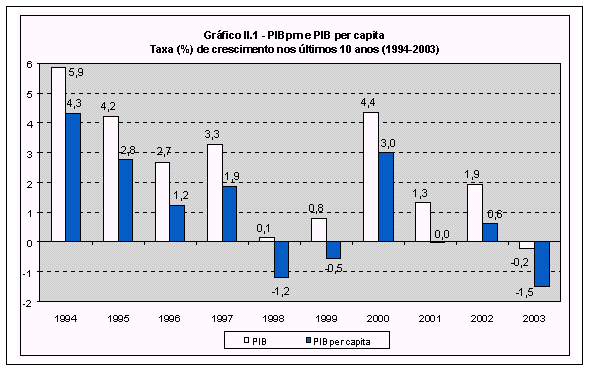
Agribusiness grows 5.0% in 2003 In 2003, Agribusiness (agriculture and animals) grew 5.0%, Industry sector shrunk 1.0% and the Services sector shrunk 0.1%. The only sub-sector of Industry which had negative variation was the civil building (-8.6%); the other sub-sectors, Minerals, Utilities Services and Transformation had positive variations of 2.8%, 1.9% and 0.7%. In the Services sector, there were negative figures in Commerce (-2.6%), Transportation (-0.8%) and Other Services (-0.5%). The graph below shows the variations in each sub-sector. 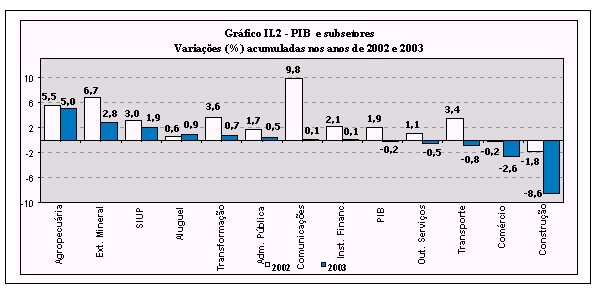 In order: Agribusiness, Mineral Extrativism, Utilities Services, Rentals, Transformation, Public Administration, Communications, Financial Sector, GNP, Other Services, Transportation, Commerce, Civil Building. Consumption of Families down by 3.3% On the demand side, the consumption of families decreased 3.3%, Government expenses increased 0.6%, and the Fixed Capital Accumulation dropped 6.6%. Exports grew 14.2% (goods: +14.8%; services: +10.9%), while imports shrunk 1.9% (goods: -4.7%; services: +8.7%). The graph below compares the variations in demand (2002: white bars; 2003: blue bars).  In order: Consumption of families, Consumption of government, Fixed Capital Accumulation, Exports, Imports Last trimester 2003 grew 1.5% compared to previous trimester GNP, after sazonal adjustements, had positive variation of 1.5% from the third to the fourth trimester of 2003. Agribusiness grew by 7.3%, Industry grew by 1.2% and Services grew by 0.8%. The peak in agribusiness is consequence of a depressed comparison basis in the third trimester (coffee had a decline in production of 20%), as well as a surge in some products in the fourth trimester (e.g. sugar cane). The graph below shows the variations by trimester for the several sectors. 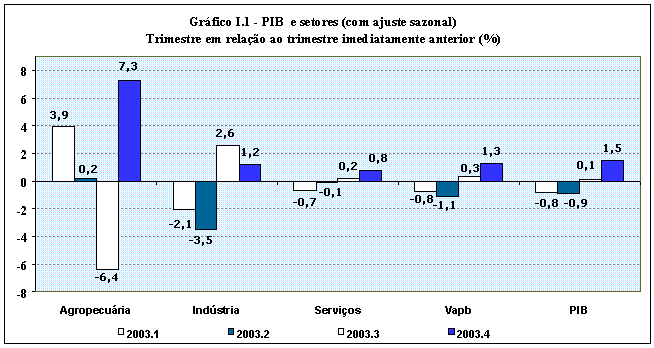
In the fourth trimester, demand picked up Investments had positive variation of 4.0% in the fourth period, compared to the previous period; the third trimester had already seen a 2.3% growth, after sharp drops in the first semester. Families spent 1.6% more in the fourth trimester than in the third. Government spent 0.1% more. Exports grew by 5.5%, and Imports 8.3%. The graph below shows a trimester by trimester variations in demand. 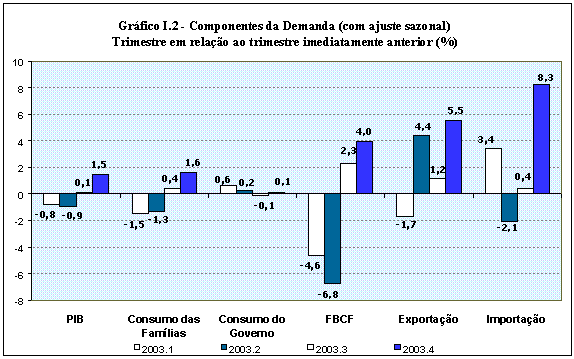 Fourth trimester 2003 down 0.1% compared to fourth trimester 2002 Comparing the last trimester of both years: Agribusiness grew 4.8%, Industry dropped 1.7%, Services grew 0.3% In the agribusiness sector, some crops had a large increase, like wheat (101.6%) and sugar cane (7.2%). In the industrial sector, civil building dropped 11.1%, a behaviour repeated since 2nd trimester 2001 (with the sole exception of the 4th trimester of 2002). All other industrial sectors experienced growths: Mineral Extraction (4.8%), Transformation (0.4%) and Public Utilities (0.1%). The negative aggregated result for the industrial sector is explained by the higher weight of the civil building industry (21%) in the total. In Services, the Rentals, Transportation and Public Administration sectors had positive variations (1.9%, 1.5% and 0.5%, respectively), while Communications, Commerce (retail and wholesales) and Other Services had negative variations (-3.6%, -0.3% and -0.3%) and Financial Services had zero variation. The Communications sector saw a reduction in growth for the second time in the historic series. Fourth trimester 2003 / Fourth trimester 2002 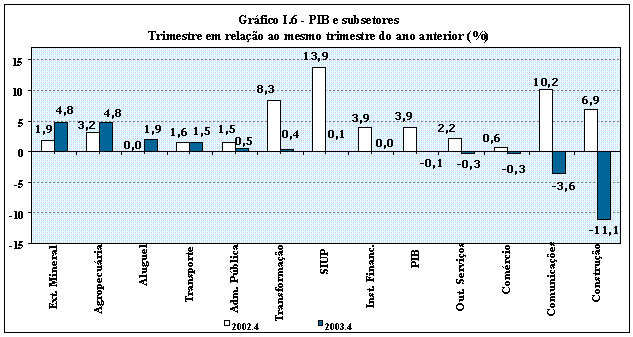 Mineral Extraction, Agribusiness, Rentals, Transportation, Public Administration, Transformation, Utilities, Financial Institutions, GNP, Other Services, Commerce, Communication, Civil Building Exports grow slower, Imports saw first growth since 2001 Comparing 4th trimester of 2003 with 4th trimester of 2002, the Families Consumption had a negative variation of 0.6%; this factor has been experiencing negative figures since the third trimester of 2001, with the exception of the third trimester of 2002. It's noticeable, however, that, albeit negative, the result of the fourth trimester is better than in the first three. The exports in the fourth trimester grew more than in the third (3.7%), but this figure is way below those which were registered in 2002, around 20%. The imports, which had been seeing decreases since the third trimester of 2001, had an increase of 10%; according to Funcex (an entity for studies on foreigner trade), there was a growth in the importation of production goods and intermediary goods, such as machinery, chemicals, electrical material and rubber. 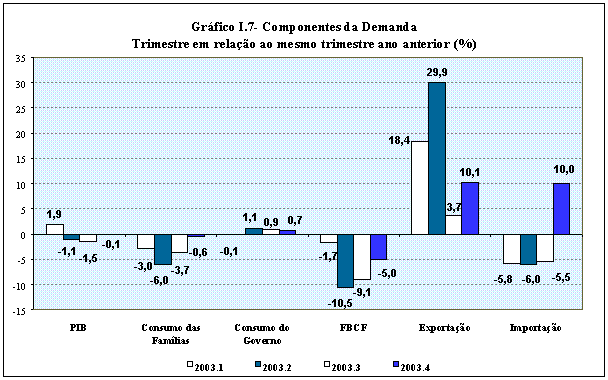
|